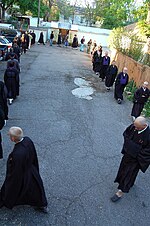Walking meditation

Walking meditation, sometimes known as kinhin (Chinese: 經行; Pinyin: jīngxíng; Romaji: kinhin or kyōgyō; Korean: gyeonghyaeng; Vietnamese: kinh hành), is a practice within several forms of Buddhism that involve movement and periods of walking between long periods of sitting meditation.[1] In different forms, the practice is common in various traditions of both Theravada and in Mahayana Buddhism.
Practice
Practitioners typically walk clockwise around a room while holding their hands in a gesture with one hand closed in a fist while the other hand grasps or covers the fist (Chinese: 叉手; pinyin: chā shǒu; rōmaji: shashu).[2] During walking meditation each step is taken after each full breath.[3] The pace of walking meditation can be either slow (several steady steps per each breath) or brisk, almost to the point of jogging.[2]
Etymology
The term kinhin consists of the Chinese words 經, meaning "to go through (like the thread in a loom)", with "sutra" as a secondary meaning, and 行, meaning "walk". Taken literally, the phrase means "to walk straight back and forth."
See also
- Ānāpānasati
- Anussati
- Buddhist meditation
- Circumambulation
- Jarāmaraṇa
- Samatha
- Shikantaza
- Vipassanā
References
- ^ Maezumi & Glassman 2002, pp. 48–9.
- ^ a b Aitken 1999, pp. 35–6.
- ^ "Kinhin". Empty Bowl Zendo. Retrieved April 1, 2015.
Sources
- Smith, L. (2023). 28 Meditation Statistics: How Many People Meditate? The Good Body. https://www.thegoodbody.com/meditation-statistics/
- Team, M. (2022). How Many People Meditate? Mindworks Meditation. https://mindworks.org/blog/how-many-people-meditate/
- Wise, J. (2023). Meditation Statistics 2023: Popularity, Industry & Market Size - EarthWeb. EarthWeb. https://earthweb.com/meditation-statistics/#:~:text=Meditation%20Statistics%202023-,Approximately%20200%20to%20500%20million%20people%20across%20the%20globe%20partake,reduce%20school%20suspensions%20by%2045%25.
Bibliography
- Aitken, Robert (1999). Taking the Path of Zen. North Point Press. pp. 35–36. ISBN 0-86547-080-4.
- Maezumi, Hakuyu Taizan; Glassman, Bernie (2002). On Zen Practice: Body, Breath, Mind. Wisdom Publications. pp. 48–49. ISBN 086171315X.
- Jin, Putai. "Efficacy of Tai Chi, Brisk Walking, Meditation, and Reading In Reducing Mental and Emotional Stress". doi.org/10.1016/0022-3999(92)90072-A
- Prakhinkit, Susaree "Effects of Buddhist Walking Meditation on glycemic control and vascular functions in patients with Type-2 Diabetes." Journal of Alternative and Complementary Medicine doi.org/10.1016/j.ctim.2016.03.009
- Prakhinkit, Susaree "Effects of Buddhism walking meditation on depression, functional fitness, and endothelium-dependent vasodilation in depressed elderly." Journal of Alternative and Complementary Medicine, vol. 20, no. 5, 2014, doi.org/10.1089/acm.2013.0205
- Chatutain, Apsornsawan “Walking Meditation Promotes Ankle Proprioception and Balance Performance among Elderly Women.” doi.org/10.1016/j.jbmt.2018.09.152
- Smith, Alison. “Walking Meditation: Being Present and Being Pilgrim on the Camino De Santiago.” Religions, vol. 9, no. 3, 2018, p. 82., doi:10.3390/rel9030082
- v
- t
- e
- Four Noble Truths
- Three Jewels
- Noble Eightfold Path
- Nirvana
- Middle Way
- Tathāgata
- Birthday
- Four sights
- Eight Great Events
- Great Renunciation
- Physical characteristics
- Life of Buddha in art
- Footprint
- Relics
- Iconography in Laos and Thailand
- Films
- Miracles
- Family
- Suddhodāna (father)
- Māyā (mother)
- Mahapajapati Gotamī (aunt, adoptive mother)
- Yaśodharā (wife)
- Rāhula (son)
- Ānanda (cousin)
- Devadatta (cousin)
- Places where the Buddha stayed
- Buddha in world religions
- Kaundinya
- Assaji
- Sāriputta
- Mahamoggallāna
- Ānanda
- Mahākassapa
- Aṅgulimāla
- Anuruddha
- Mahākaccana
- Nanda
- Subhūti
- Punna
- Upāli
- Mahapajapati Gotamī
- Khema
- Uppalavanna
- Asita
- Channa
- Yasa
- Avidyā (Ignorance)
- Bardo
- Bodhicitta
- Buddha-nature
- Dhamma theory
- Dharma
- Enlightenment
- Five hindrances
- Indriya
- Karma
- Kleshas
- Mental factors
- Mindstream
- Parinirvana
- Pratītyasamutpāda
- Rebirth
- Saṃsāra
- Saṅkhāra
- Skandha
- Śūnyatā
- Taṇhā (Craving)
- Tathātā
- Ten Fetters
- Three marks of existence
- Two truths doctrine
- Ten spiritual realms
- Six realms
- Deva realm
- Human realm
- Asura realm
- Hungry Ghost realm
- Animal realm
- Naraka
- Three planes of existence
- Bhavana
- Bodhipakkhiyādhammā
- Brahmavihara
- Buddhābhiṣeka
- Dāna
- Devotion
- Deity yoga
- Dhyāna
- Faith
- Five Strengths
- Iddhipada
- Meditation
- Merit
- Mindfulness
- Nekkhamma
- Nianfo
- Pāramitā
- Paritta
- Puja
- Offerings
- Prostration
- Chanting
- Refuge
- Sādhu
- Satya
- Seven Factors of Enlightenment
- Sati
- Dhamma vicaya
- Pīti
- Passaddhi
- Śīla
- Threefold Training
- Vīrya
- Twenty-two vows of Ambedkar
- Gautama Buddha
- Nagasena
- Aśvaghoṣa
- Nagarjuna
- Asanga
- Vasubandhu
- Kumārajīva
- Buddhaghosa
- Buddhapālita
- Dignāga
- Bodhidharma
- Zhiyi
- Emperor Wen of Sui
- Songtsen Gampo
- Xuanzang
- Shandao
- Padmasambhāva
- Saraha
- Atiśa
- Naropa
- Karmapa
- Hōnen
- Shinran
- Dōgen
- Nichiren
- Shamarpa
- Dalai Lama
- Panchen Lama
- Ajahn Mun
- B. R. Ambedkar
- Ajahn Chah
- Thích Nhất Hạnh
- Timeline
- Ashoka
- Kanishka
- Buddhist councils
- History of Buddhism in India
- Great Anti-Buddhist Persecution
- Greco-Buddhism
- Buddhism and the Roman world
- Buddhism in the West
- Silk Road transmission of Buddhism
- Persecution of Buddhists
- Banishment of Buddhist monks from Nepal
- Buddhist crisis
- Sinhalese Buddhist nationalism
- Buddhist modernism
- Vipassana movement
- 969 Movement
- Women in Buddhism
- Abhijñā
- Amitābha
- Brahmā
- Dharma talk
- Hinayana
- Kalpa
- Koliya
- Lineage
- Māra
- Ṛddhi
- Siddhi
- Sacred languages
 Category
Category Religion portal
Religion portal













